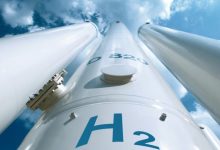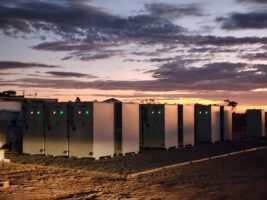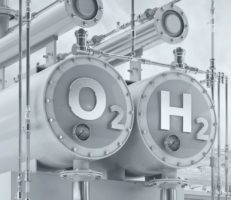Regular RenewEconomy readers will be aware of several Aussie trials and proposals to use hydrogen to transport and store energy. Discussion of hydrogen’s drawbacks has been much less prominent, with the notable exception of Tim Forcey’s articles warning against fossil-fuel interests using technology’s “green” image as a fig-leaf to continue polluting activities.
Renew (no relation to RenewEconomy) recently prepared a discussion paper assessing hydrogen’s prospects across various potential uses. Results are summarised in the following table, and highlights are presented below.
| Potential use of renewable hydrogen | Notes |
| Energy exports | Yes, e.g. to energy-poor Japan. Possibly in the form of ammonia. |
| Inter-seasonal energy storage | Yes. Supplementary supply during cloudy, calm weeks. |
| Industrial, e.g. producing steel | Yes. Longer-term priority. |
| Road transport | Only in niche roles. Battery electric vehicles are much more efficient. |
| Main electricity supply | No – more direct use of renewable generation is more efficient. |
| In homes and businesses | No – efficient electric appliances are much more economic. |
Hydrogen’s main drawback: Inefficiency
A major drawback of hydrogen is that it involves several processing steps, and much energy is wasted in each one. Let’s consider propelling a Fuel Cell Electric Vehicle (FCEV) such as the Toyota Mirai, versus its Battery-Electric Vehicle (BEV) equivalent. Starting with renewable electricity, only one-third makes it to the FCEV’s wheels in the most optimistic scenario. With a BEV instead, one-half to three-quarters of the original energy is transferred to the vehicle wheels. The following chart illustrates how much energy is lost in each step.

Since hydrogen is a relatively inefficient carrier of renewable electricity, it requires more generators to supply it. For example, five solar panels in Sydney can propel a BEV on daily 30km round-trip commutes on an annual average basis. On the other hand, an FCEV requires around 14 panels – 2.8 times as many as the BEV.

Exports to Japan: efficiency not such a problem
Japan is energy-poor and relies almost entirely on imports of fossil fuel and uranium. The nation has little suitable land available to host solar farms or wind farms. Japan’s response is a firm strategy toward hydrogen, which states that by 2030 the country will develop supply chains to import 300,000 tons of hydrogen annually. The clear intent is to import multi-use hydrogen generated from renewable energy rather than from fossil fuels, to meet Japan’s commitment to the Paris agreement. Korea and China may similarly import hydrogen.
In contrast to Japan, the Pilbara region of Western Australia currently has an enormous, high-quality renewable energy resource but no significant market. Local electricity consumption is relatively small, and the remote area has no transmission line to Perth, let alone the eastern states.
A massive project[1]is in early-stage development to produce hydrogen in the Pilbara via electricity generated by wind and solar farms. This will be exported as either liquefied hydrogen or in the form of ammonia. The following chart estimates the energy lost at each stage, for three different options plus a reference case generating solar electricity locally in Japan.

Options (a) and (b) are further illustrated in the following diagram.

Option (b) seems quite attractive. Although it requires a larger solar farm than option (a), it has several advantages. Land in the Pilbara is cheap and abundant compared to Japan, and the ammonia could be stored for a long time.
Practical issues with hydrogen
Several practicalities are noted in our discussion paper, including:
- Hydrogen is costly to work with since it can soak through materials and embrittle steel.
- Hydrogen gas in a FCEV’s fuel tank is compressed to pressures found in a shotgun barrel.
- The Toyota Mirai’s carbon-fibre fuel tank has a volume of 122 litres, weighs 88 kg empty and can hold 5 kg of hydrogen.
- The first hydrogen transport ship is currently under construction. The gas will be liquefied by freezing to within twenty degrees of absolute zero (-253 degrees C) and stored in two stainless-steel tanks each with a vacuum-separated double wall acting like a thermos flask.
- Hydrogen can be shipped in the form of ammonia at the more moderate temperature of -34C, using standard existing ships.
- If the event of a tank rupture, hydrogen can produce a very energetic explosion and its flame is invisible, but on the other hand ammonia gas can create a toxic, heavier-than-air cloud.
- If hydrogen gas was piped into homes and businesses instead of fossil natural gas, all gas appliances would need to be replaced and hydrogen detectors may need to be fitted alongside smoke detectors.
Conclusion
Hydrogen produced from renewable energy is a renewable, storable fuel but it has several drawbacks and should only be pursued when more direct uses of renewable energy are impractical. Australia should not devote resources to a network of hydrogen refuelling stations because battery charging is much more efficient. Hydrogen should not be piped into homes and businesses because efficient electric appliances are much more economic. And we should be wary of hydrogen proposals used as a fig leaf to continue fossil-fuel business-as-usual.
Exporting renewable hydrogen to countries with poor renewable resources is a great opportunity and has the potential to replace our fossil fuel exports.
For deeper analysis and references, please refer to our discussion paper.










